
Garforth is a town in the metropolitan borough of the City of Leeds, West Yorkshire, England.

Aberford is a village and civil parish on the eastern outskirts of the City of Leeds in West Yorkshire, England. It had a population of 1,059 at the 2001 census, increasing to 1,180 at the 2011 Census. It is situated 10 miles (15.5 km) east, north east of Leeds and west of the A1(M) motorway.
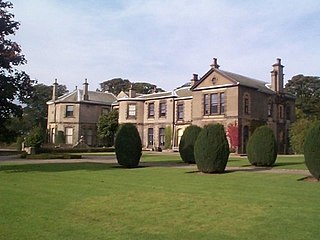
Lotherton Hall is a country house near Aberford in West Yorkshire, England. It is a short distance from the A1(M) motorway, 200 miles (320 km) equidistant from London and Edinburgh. It is one of nine sites in the Leeds Museums & Galleries group.

Scholes-in-Elmet is a village in Leeds, West Yorkshire, England. Its name is a plural of Old Norse skáli meaning "temporary shed".
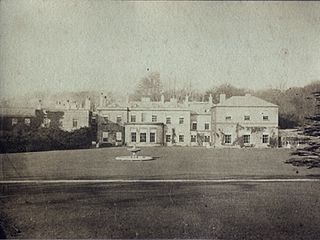
Parlington Hall was the seat of the Gascoigne family, Aberford near Leeds in West Yorkshire, England.

The Gascoigne Baronetcy, of Barnbow and Parlington in the County of York, was a title in the Baronetage of Nova Scotia. It was created on 8 June 1635 for John Gascoigne. He had converted to Roman Catholicism in 1604. His daughter, Catherine Gascoigne, went to Cambrai where she became an abbess. Gascoigne's son Sir Thomas, 2nd Baronet, was accused of conspiracy to murder King Charles II as part of the mythical Popish Plot, but acquitted. The eighth Baronet was Member of Parliament for Thirsk, Malton and Arundel. He renounced Catholicism, and was much involved in the Irish Parliament and in horse racing. Sir Thomas died in 1810, the year after his only son died in a hunting accident, upon which the baronetcy became either extinct or dormant.
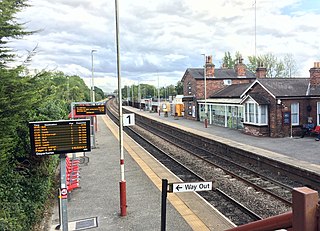
Garforth railway station serves the town of Garforth in West Yorkshire, England. It is one of the two stations in Garforth the other being East Garforth which is situated about 0.5 miles east from the main station and which was opened in 1987. It lies on the Selby Line. Garforth is 7.1 miles (11.5 km) east of Leeds and 16 miles (26 km) south-west of York. The station is served by Northern and TransPennine Express services.

The Middleton Railway is the world's oldest continuously working railway, situated in the English city of Leeds. It was founded in 1758 and is now a heritage railway, run by volunteers from The Middleton Railway Trust Ltd. since 1960.

Micklefield is a village and civil parish in the City of Leeds in West Yorkshire, England. It neighbours Garforth, Aberford and Brotherton and is close to the A1(M) motorway. The population as of the 2011 Census was 1,893, increased from 1,852 in 2001.
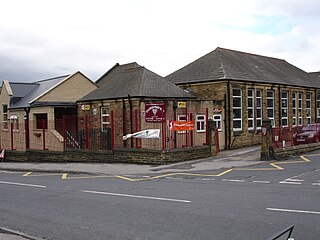
Woodlesford is a suburban village in the City of Leeds, West Yorkshire, England, 6 miles (10 km) south-east of Leeds city centre. Formerly part of the Rothwell Urban District, it is now within the Rothwell ward of Leeds City Council. The village sits on the banks of the Aire and Calder Navigation and river system.
The Leeds and Selby Railway was an early British railway company and first mainline railway within Yorkshire. It was opened in 1834.

Thomas Gascoigne was a Yorkshire land and coal-owner.

Selby coalfield was a large-scale deep underground mine complex based around Selby, North Yorkshire, England, with pitheads at Wistow Mine, Stillingfleet Mine, Riccall Mine, North Selby Mine, Whitemoor Mine and at Gascoigne Wood Mine; all coal was brought to the surface and treated at Gascoigne Wood, being distributed onwards by rail. The primary purpose of the pit was to supply coal for electrical power generation; much of it was used in the nearby Aire valley power stations.

Sir Thomas Gascoigne, 8th Baronet was born on 7 March 1745 on the Continent into a devout Catholic gentry family based in Yorkshire. Despite receiving a solid Catholic education at institutions in northern France and Italy, Gascoigne would later renounce his religion to become a Foxite Whig Member of Parliament. Prior to his apostasy, he travelled extensively as a Grand Tourist throughout much of Spain, France and Italy in the company of the noted travel writer Henry Swinburne, who would later record their journeys in two popular travel guides Travels through Spain in the Years 1775 and 1776 (1779) and Travels in the Two Sicilies, 1777–1780 (1783–5). Together they gained close access to the leading courts of Europe, particularly in Spain and Naples. An honorary member of the Board of Agriculture, Gascoigne was an important advocate of agricultural reform as well as a considerable coal owner who helped pioneer technological developments in the extractive industries. He is emblematic of how movements within the Enlightenment were having a major influence on the attitudes, activities and outlook of many leading English Catholic gentry families in the period.
National Cycle Network (NCN) Route 66 is a Sustrans National Route that runs from Kingston upon Hull to Manchester via Beverley, York and Leeds.

The Castleford–Garforth line was a single-track railway line in West Yorkshire, England, connecting Castleford with Garforth east of Leeds. The route was developed to allow coal to be transported from the area, though a passenger service was operated between 1878 and 1951. Initially promoted by Leeds, Castleford and Pontefract Junction Railway, it was taken over by the North Eastern Railway before the line was completed.
Richard Philip Oliver, later known as Richard Oliver Gascoigne, was an Irish landowner at Castle Oliver in County Limerick and Parlington Hall in Yorkshire.
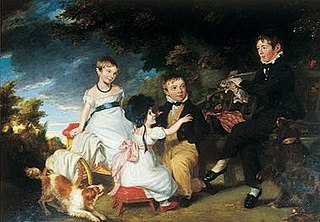
Elizabeth Gascoigne was the heiress to the Gascoigne estate, eventually becoming the main owner of Lotherton Hall in Leeds which is now owned by Leeds City Council as part of the Leeds Museums and Galleries. She was a woman of many talents, dabbling in writing books, designing stained glass windows, playing the harp and being a charitable contributor to the community of Leeds, mainly Aberford in Yorkshire and Ashtown in Ireland. Her works in stained glass have been displayed in exhibitions, and many of the buildings her and her sister commissioned are still part of the communities that they lived in.

Parlington is a civil parish that includes part of Aberford, in the City of Leeds in West Yorkshire, England. In 2001 the parish had a population of 87. The parish touches Aberford, Barwick in Elmet and Scholes, Lotherton cum Aberford, Micklefield and Sturton Grange. Aberford & District Parish Council includes Parlington along with Aberford, Lotherton cum Aberford and Sturton Grange. There are plans to build a garden village in Parlington.
Gascoigne Wood Junction railway station was a railway station near Sherburn-in-Elmet in North Yorkshire, England. It was originally opened as a junction station, enabling transfers for passengers between trains. It was later a private halt station for the staff who worked at the Gascoigne Wood marshalling yard. It opened in 1839, and was closed, renamed and re-opened several times before closing completely in 1959. The station was 14 miles (23 km) from Leeds New Station, and 6 miles (9.7 km) from Selby.













